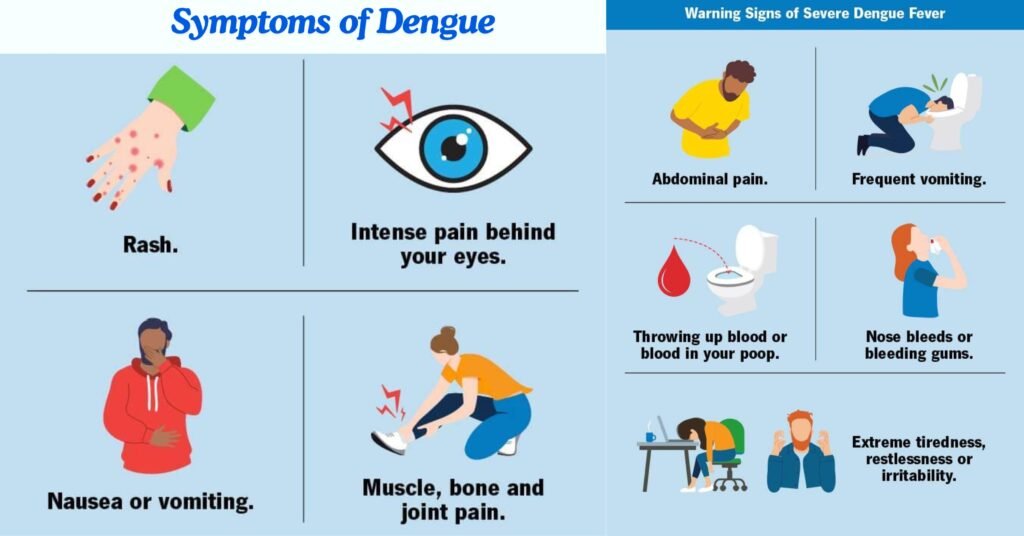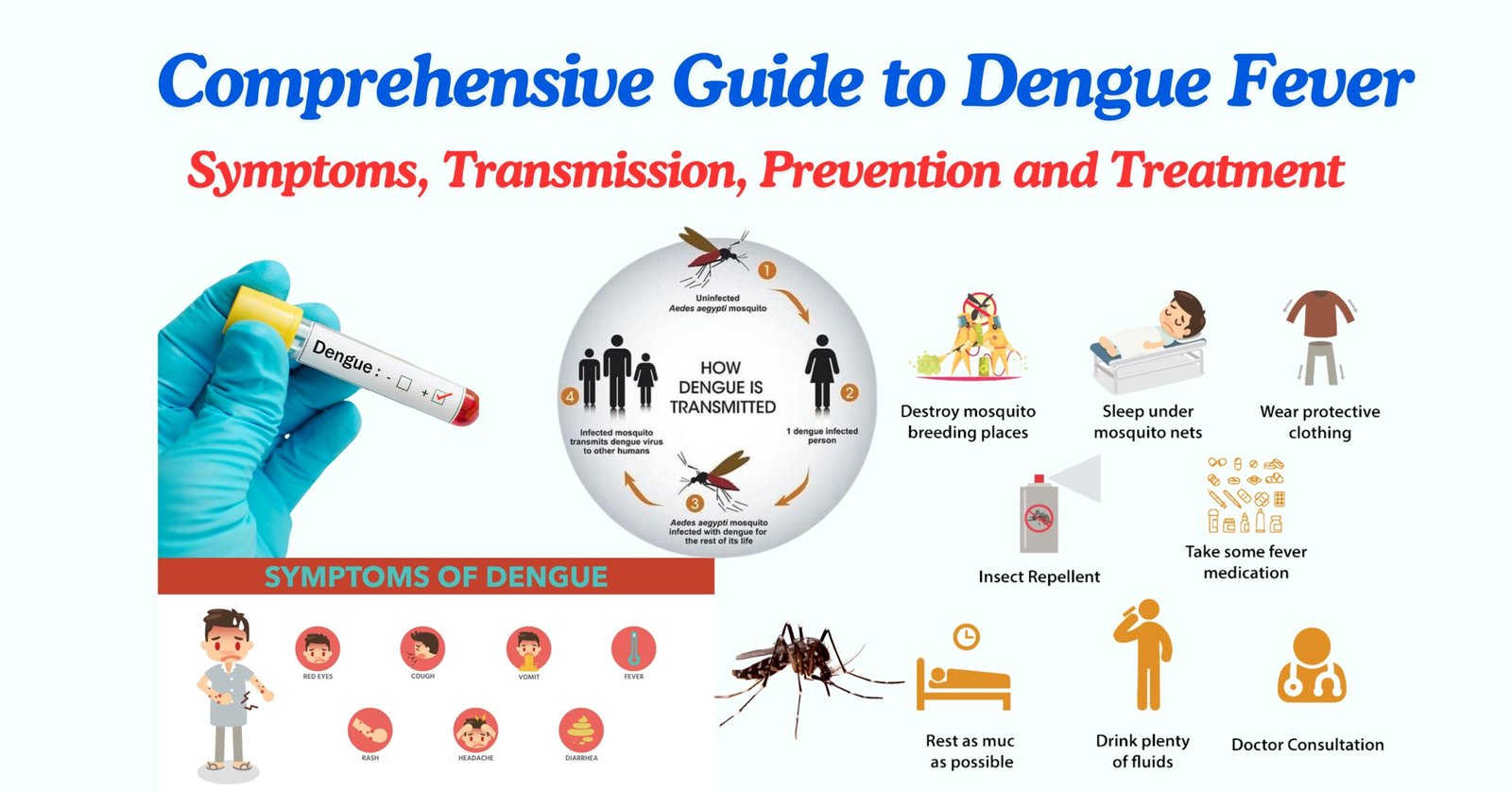Introduction
Dengue fever is a mosquito-borne viral disease that can cause a significant public health risk in tropical and subtropical regions around the world. With increasing global travel and urbanization, dengue fever has become a global concern, affecting millions of people each year. The World Health Organization (WHO) estimates that approximately 390 million infections occur annually, with around 96 million resulting in clinical symptoms. This article will provide an overview of dengue fever, its symptoms, transmission, treatment, and preventive measures.
What is Dengue Fever?
Dengue fever is caused by the dengue virus, which belongs to the Flavivirus genus. The virus is transmitted to humans primarily through the bite of infected female mosquitoes, particularly the Aedes aegypti mosquito. Less commonly, the Aedes albopictus mosquito can also be a vector.
Dengue virus has four distinct serotypes (DENV-1, DENV-2, DENV-3, and DENV-4). An individual infected with one serotype becomes immune to that specific serotype for life but can still be infected by the other three serotypes, often leading to more severe complications.
Symptoms of Dengue Fever

The symptoms of dengue fever typically develop 4 to 10 days after being bitten by an infected mosquito. In many cases, the infection is asymptomatic, meaning no symptoms are present, but when symptoms do occur, they can range from mild to severe.
Mild dengue fever symptoms:
1.High fever (up to 104°F or 40°C).
2.Severe headache.
3.Pain behind the eyes.
4.Muscle and joint pains (often referred to as “breakbone fever”).
5.Nausea and vomiting.
6.Skin rash, which may appear 2-5 days after the onset of fever.
7.Mild bleeding (such as nosebleeds or gum bleeding).
Severe dengue (also known as dengue hemorrhagic fever or dengue shock syndrome):
•Severe abdominal pain.
•Persistent vomiting.
•Bleeding from gums or nose.
•Blood in vomit or stool.
•Difficulty breathing.
•Rapid drop in blood pressure (shock).
Severe dengue is life-threatening and requires immediate medical assistance. If not treated promptly, it can lead to shock, internal bleeding, organ failure, and death.
How dengue is transmitted?

Dengue fever is transmitted by the bite of infected Aedes mosquitoes. These mosquitoes become carriers of the dengue virus after biting a person already infected with the virus. Once infected, the mosquito can transmit the virus to other individuals through subsequent bites.
Aedes mosquitoes are most active during the daytime, particularly during early morning and late afternoon. They thrive in stagnant water and urban areas, making densely populated cities in tropical climates particularly susceptible to dengue outbreaks.
Dengue is not spread directly from person to person. However, in rare cases, it can be transmitted through blood transfusions, organ transplants, and from mother to fetus during pregnancy.
Diagnosis and Treatment:
Dengue fever is typically diagnosed through blood tests that detect the presence of the virus, viral antigens, or antibodies produced by the immune system. Early diagnosis is important, especially in regions where dengue is endemic, as it helps prevent complications.
There is no specific antiviral treatment for dengue fever. The management of the disease is basically supportive and focuses on relieving symptoms. Treatment often includes:
•Rest and hydration:
Patients are encouraged to drink plenty of fluids to avoid dehydration.
•Fever and pain relief:
Acetaminophen (paracetamol) is recommended to control fever and reduce pain. Non-steroidal anti-inflammatory drugs (NSAIDs) such as aspirin or ibuprofen are avoided due to the risk of bleeding.
•Hospitalization:
In cases of severe dengue, hospitalization is required for close monitoring, fluid replacement, and supportive care.
Dietary Requirements for dengue patient:
Nutrition plays a crucial role in supporting the immune system and aiding recovery during dengue fever. While there is no specific diet to cure dengue, certain foods can help boost
immunity, maintain hydration, and support faster recovery. Here’s a guide to the best foods to take during dengue:
1) Hydrating Fluids
Staying hydrated is the most important aspect of dengue treatment as high fever and vomiting can lead to dehydration. Fluids help maintain electrolyte balance and reduce the severity of symptoms. The most useful fluids are water, coconut water, ORS, lemon water, herbal teas, soups and broth.
2) Vitamin C-Rich Foods
Vitamin C is essential for boosting the immune system, which is critical in fighting viral infections like dengue. It also aids in the absorption of iron, which is important for recovery. The best sources of vitamin c are citrus fruits, guava, berries, papaya and kiwi.
3) Foods to Boost Platelet Count
A drop in platelet count is one of the dangerous complications of dengue fever. Some foods are thought to support healthy platelet levels such as papaya leaves, beetroot, pomegranate and fenugreek seeds.
4) Protein-Rich Foods
During dengue, the body is in a weakened state, and protein is essential to help rebuild tissues and strengthen the immune system. The primary source of protein includes eggs, chicken soup, lentils, tofu and fish.
5) Iron-Rich Foods
Dengue often leads to fatigue and weakness, partly due to a drop in red blood cells and platelet counts. Iron-rich foods can help combat this and improve hemoglobin levels. Some of the iron rich foods are spinach, red meat, legumes, dates and raisins.
Foods Rich in Antioxidants
Antioxidants help in repairing cellular damage caused by the virus and strengthen the immune system to fight the infection. Antioxidants rich foods are berries, green leafy vegetables and tomatoes.
Foods to Avoid during Dengue fever:
Certain foods and beverages can enhance symptoms of dengue fever or slow down recovery process. Therefore, it is better to avoid these:
•Caffeine: Dehydrates the body, which is already at risk of dehydration due to dengue.
•Spicy Foods: Can irritate the stomach and exacerbate nausea or vomiting.
•Fried and Fatty Foods: Difficult to digest and can lead to discomfort.
•Sugary Foods: Processed
Prevention of Dengue Fever:
Since there is no specific cure for dengue, prevention is critical in controlling its spread. Key preventive measures include:
1.Avoid Mosquito Bites: Wear long-sleeved clothing, use insect repellent, and sleep under mosquito nets to reduce the risk of being bitten by mosquitoes.
2.Eliminate Mosquito Breeding Sites: Aedes mosquitoes breed in stagnant water, so it is essential to eliminate standing water in containers, pots, old tires, and other areas around homes where mosquitoes can breed.
3.Use of Mosquito Control Measures: Community-based efforts, such as fumigation, the use of larvicides, and the release of mosquitoes infected with the Wolbachia bacteria (which prevents dengue transmission), have shown promise in reducing mosquito populations.
4.Vaccination: In recent years, a dengue vaccine called Dengvaxia has been approved in some countries. However, it is only recommended for individuals who have previously been infected with dengue, as it can increase the risk of severe dengue in those who have never been exposed to the virus.
Prevalence of Dengue in Pakistan:
Dengue fever has emerged as a significant public health issue in Pakistan over the past two decades. The country has witnessed periodic outbreaks, particularly during the monsoon season, as the Aedes mosquitoes thrive in the humid and warm environment. This mosquito-borne viral infection affects thousands of people annually, putting a significant strain on the healthcare system.
Pakistan reported its first major dengue outbreak in 1994 in Karachi, but it wasn’t until 2005 that dengue gained widespread attention due to a severe outbreak in the same city. Since then, the country has experienced seasonal outbreaks, with significant spikes in cases occurring in years with heavy rainfall and insufficient mosquito control measures.
Some of the worst outbreaks occurred in:
•2011: Over 21,000 cases and 350 deaths, primarily in Lahore and Punjab.
•2019: A record-breaking year, with over 47,000 cases and more than 70 deaths reported across the country, affecting major cities like Karachi, Islamabad, Rawalpindi, and Peshawar.
Recent Trends
In recent years, dengue cases have continued to surge in Pakistan. The trend shows a significant rise in dengue infections due to urbanization, poor drainage systems, water storage practices, and changing climate patterns that favor mosquito breeding. From 2020 onwards, Pakistan has been reporting an increasing number of dengue cases each year, with spikes during the post-monsoon period (August to November).
The 2023 dengue season saw the continuation of this upward trend, with major cities like Karachi, Lahore, Islamabad, and Rawalpindi again being hot spots for the disease. The healthcare system faced challenges due to the convergence of dengue with other health issues like the COVID-19 pandemic, making it more difficult to manage the spread.
Regional Variations
Dengue affects all provinces in Pakistan, but the incidence and impact vary:
•Punjab: The most populous province, including major cities like Lahore and Rawalpindi, experiences the highest number of cases. Lahore, in particular, has been the epicenter of multiple outbreaks.
•Sindh: Karachi, being a densely populated urban center with poor sanitation and stagnant water, has consistently reported high dengue infection rates.
•Khyber Pakhtunkhwa (KPK): The incidence of dengue has increased in recent years, with Peshawar being the hardest-hit city.
•Balochistan: The southwestern province reports fewer cases compared to other regions, but there has been a rising trend in dengue infections, particularly in urban areas like Quetta.
Challenges Contributing to Dengue Prevalence
1.Urbanization and Unplanned Infrastructure: Rapid urban growth without adequate sanitation or drainage systems has created ideal breeding grounds for the Aedes mosquitoes, especially in cities like Karachi and Lahore.
2.Water Storage Practices: Many households store water in open containers due to irregular water supply, providing ideal environments for mosquitoes to breed.
3.Climate Change: Warmer temperatures and unpredictable rain patterns have expanded the breeding season of mosquitoes. Prolonged monsoon periods contribute to the growth of mosquito populations.
4.Inadequate Mosquito Control Measures: Although the government conducts fumigation campaigns, these are often reactive, occurring after an outbreak begins, rather than preventive. Insufficient resources and coordination also hamper the effectiveness of mosquito control.
Government and Public Health Response
In response to increasing dengue cases, the Pakistani government has taken several measures:
•Fumigation drives: Seasonal fumigation is conducted in major cities, especially during the monsoon season, to reduce mosquito populations.
•Public Awareness Campaigns: Educational campaigns are launched to inform citizens about preventive measures such as eliminating stagnant water, using mosquito repellents, and ensuring proper sanitation around homes.
•Dengue Surveillance Programs: The government has established surveillance systems to monitor the spread of dengue and track new cases. Early diagnosis and treatment are emphasized to reduce fatalities.
•Healthcare Initiatives: Hospitals have set up dedicated dengue wards during peak seasons to handle the surge of patients. Healthcare workers are trained to manage dengue cases effectively, with particular attention to severe cases that can lead to dengue hemorrhagic fever or shock syndrome.
Outlook and Future Directions
With climate change, rapid urbanization, and increasing mosquito resistance to control measures, the prevalence of dengue in Pakistan is expected to remain a challenge. More proactive and sustainable approaches are needed to control mosquito populations, improve urban planning, and enhance public health infrastructure. Continued research into dengue vaccines and treatments will also play a crucial role in managing future outbreaks.
In the meantime, public awareness and community involvement in reducing mosquito breeding sites remain crucial to mitigating the spread of dengue. Collaborative efforts between the government, healthcare professionals, and the general public can help reduce the disease’s burden and protect vulnerable populations from future outbreaks.
Global Impact and Future Directions
Dengue fever is now endemic in over 100 countries, with an estimated 40% of the world’s population at risk. Climate change, increased urbanization, and global travel have all contributed to the spread of the disease to new regions, including parts of Europe and the southern United States.
Research into new vaccines, antiviral therapies, and mosquito control methods continues to advance. Scientists are also working on genetically modified mosquitoes and innovative biological controls, such as releasing mosquitoes that are unable to transmit the virus.
Conclusion
Dengue fever remains a significant global health challenge, particularly in tropical and subtropical regions. While there is no cure for the disease, preventive measures, early diagnosis, and proper medical care can significantly reduce the risk of severe complications and fatalities.
Public health efforts aimed at reducing mosquito populations and preventing transmission are key to controlling the spread of this disease.






2 Comments.